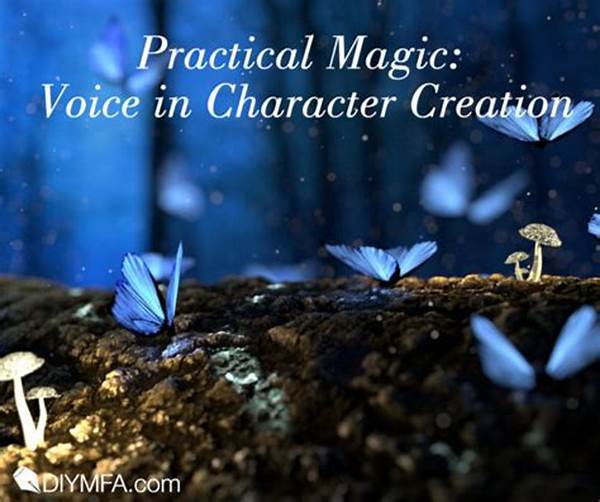Creating a character’s voice is much more than just assigning them a specific tone or pitch; it’s about breathing life into them and making them resonate with the audience. Voice development in character creation plays a vital role in storytelling, whether it’s for a novel, a film, or a video game. Crafting a unique voice involves understanding the character’s background, emotions, and motivations, which ultimately helps connect the character with the audience on a deeper level.
Understanding the Essence of Voice Development
At its core, voice development in character creation is about exploring who the character truly is. Every character has a unique personality, backstory, and set of experiences that influence how they communicate. It’s not just about what the character says, but how they say it. The nuances in their speech patterns, their choice of words, and the rhythm of their delivery all contribute to defining their voice. This intricate process helps in transforming a simple character sketch into a three-dimensional persona. By developing a distinctive voice, storytellers can ensure each character stands out and leaves a lasting impression.
Effective voice development in character creation is akin to getting to know a new friend. Just as you discover more about a person as you interact with them, a character’s voice unfolds through dialogue and interactions. Dialogue is not merely a tool for conversation, but a vehicle for revealing a character’s charm, quirks, and even contradictions. Through careful attention to the subtleties of language, voice development enables characters to leap off the page or screen, making them memorable and engaging.
Techniques for Crafting Unique Character Voices
1. Character Background: Voice development in character creation begins with a thorough understanding of the character’s past. Their upbringing influences their speech and behavior, enriching their voice with authenticity.
2. Personality Traits: By mapping out a character’s personality traits, writers can tailor their dialogue to reflect these attributes, further enhancing the character’s voice.
3. Cultural Influences: Incorporating cultural nuances can add layers to a character’s voice, making it more distinct and relatable.
4. Emotional Range: A well-developed voice showcases a character’s emotional depth, portraying variations in tone during different situations.
5. Dialogue Dynamics: Voice development in character creation also focuses on crafting dialogues that flow naturally, capturing the spontaneity and essence of real conversations.
Exploring Depth with Voice Development
Voice development in character creation is an art that extends beyond mere vocal attributes. It’s about delving into the psyche of the character and unearthing what makes them tick. By understanding their fears, dreams, and desires, creators can fine-tune their voices to reflect these elements. Every utterance becomes a window into the character’s soul, making interactions feel genuine and impactful.
When creators focus on voice development, they can craft characters that are not just archetypes but individuals with unique perspectives. This authenticity fosters a deep emotional connection with the audience, allowing them to empathize with the character’s journey. By investing time in understanding and cultivating a character’s voice, storytellers can create vibrant, unforgettable worlds.
The Role of Authenticity in Voice Development
1. Genuine Expressions: Voice development in character creation ensures that a character’s words resonate with authenticity, avoiding clichés and fostering genuine connections.
2. Unique Vocabulary: Each character’s choice of words is a reflection of their personality, enhancing their individuality.
3. Subtext and Implications: The art of saying one thing and meaning another is an integral part of voice development, adding depth to dialogue.
4. Speech Patterns: How a character phrases their sentences contributes to the uniqueness of their voice, affecting how audiences perceive them.
5. Consistent Tone: A consistent voice tone throughout the narrative reinforces the character’s identity, ensuring coherence.
6. Accent and Dialect: Specific accents or dialects can define a character’s background, enriching their voice development.
7. Conflict Resolution Style: How characters address conflicts is often expressed through their voice, revealing more about their nature.
8. Use of Humor or Sarcasm: A character’s voice can be laced with humor or sarcasm, providing insight into their viewpoint or coping mechanisms.
9. Empathy and Compassion: Characters with empathetic voice development invite audiences to connect more deeply with their story.
10. Evolution Over Time: As characters evolve, so does their voice, reflecting their growth and changes throughout the narrative.
Building Emotional Resonance through Voice
Voice development in character creation is pivotal for building emotional resonance. By understanding the spectrum of human emotions that a character can express, creators can craft nuanced dialogues that evoke empathy and connection. When a character’s voice can convey vulnerability, strength, love, or fear convincingly, it invites the audience to share in their emotional journey, creating a lasting impact.
Ultimately, the goal of voice development is to ensure that characters are more than just participants in a story. They become companions, guides, and reflective mirrors to our own experiences. By mastering the art of voice development in character creation, creators offer audiences the opportunity to explore the infinite tapestry of human experience through diverse, compelling character voices.
The Emotional Impact of Character Voice
Creating a compelling character involves understanding the voice’s emotional range. Voice development in character creation allows writers to explore a vast array of emotional expressions, from joy to grief. This expressiveness is key to crafting characters that audiences can relate to on a personal level. A character’s voice enriches the narrative, making moments of triumph or despair more impactful. By meticulously crafting the emotional tones within a character’s voice, storytellers can guide their audience through a cathartic journey, enhancing the storytelling experience.
Conclusion: Breathing Life into Characters
Voice development in character creation is an essential tool for storytellers aiming to breathe life into their narratives. Through careful attention to the intricacies of voice, storytellers can cultivate characters that resonate with authenticity and complexity. As creators weave voices into their characters, they not only tell a story but also invite the audience to explore new perspectives and emotions. This transformative process is what makes stories memorable, offering a timeless connection between the characters and those who experience them.
